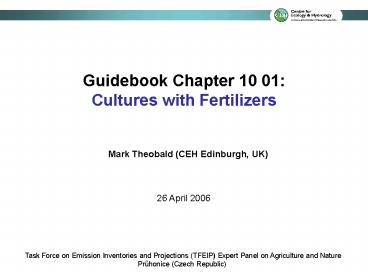Guidebook Chapter 10 01: - PowerPoint PPT Presentation
1 / 9
Title:
Guidebook Chapter 10 01:
Description:
Emissions of ammonia (NH3), nitrous oxide (N2O), other oxides of nitrogen (NOx) ... Nitrous oxide: References to studies investigating effect on emissions of ... – PowerPoint PPT presentation
Number of Views:33
Avg rating:3.0/5.0
Title: Guidebook Chapter 10 01:
1
Guidebook Chapter 10 01 Cultures with Fertilizers
Mark Theobald (CEH Edinburgh, UK)
26 April 2006
Task Force on Emission Inventories and
Projections (TFEIP) Expert Panel on Agriculture
and Nature Pruhonice (Czech Republic)
2
Chapter Overview
Emissions of ammonia (NH3), nitrous oxide (N2O),
other oxides of nitrogen (NOx), carbon dioxide
(CO2), methane (CH4), and non-methane volatile
organic compounds (NMVOCs) from agricultural
soils to which nitrogen (N)-containing
fertilizers are applied
Permanent Crops Arable land crops Rice
fields Market Gardening
- General information on the pollutants
- Factors controlling emissions
- Simple/Detailed methodologies
- Uncertainties/Areas for improvement
3
General Info
Ammonia New source Application of the herbicide
glufosinate - up to 10 of weed canopy N
content emitted as NH3
Nitrous oxide References to studies
investigating effect on emissions of
different - Fertilizer types - Crop types -
Weather/climate
Nitric oxide References to emission factors for
different fertilizer types and the pulsing
effect
4
Emission calculation methodologies
Ammonia Existing simple methodology - Multiply
amount of N applied by
Fertilizer type Ammonium sulphate 0.08
Ammonium nitrate 0.02 Calcium ammonium
nitrate 0.02 Anhydrous ammonia 0.04 Urea
0.15 Nitrogen solution 0.08 Combined
ammonium phosphates 0.05 Mono-ammonium phosphate
0.02 Di-ammonium phosphate 0.05 Other
complex NK, NPK fert 0.02
5
Ammonia Existing simple methodology
Meeting of the Agriculture and Nature Panel
Vienna October 2002
- Working Group recommendation
- Need to calculate emissions depending on climate
class - Region A ts gt 13 C
- Region B 6 C lt ts lt 13 C
- Region C ts lt 6 C
- However, in the 2003 update this method was used
in the detailed methodology - New detailed methodology is required first
6
Emission calculation methodologies
Ammonia Existing detailed methodology - Multiply
amount of N applied by
Fertilizer type Region A Region B Region C Multiplier
EFA EFB EFC c
Ammonium sulphate 0.025 0.020 0.015 10
Ammonium nitrate 0.020 0.015 0.010 1
Calcium ammonium nitrate 0.020 0.015 0.010 1
Anhydrous ammonia 0.04 0.03 0.02 4
Urea 0.20 0.17 0.15 1
Nitrogen solutions 0.11 0.09 0.07 1
Ammonium phosphates 0.025 0.020 0.015 10
Other NK and NPK 0.020 0.015 0.010 1
Nitrate only (e.g. KNO3) 0.007 0.005 0.005 1
7
Ammonia Updating the detailed methodology
- Current methodology is based largely on expert
judgement - T and pH effects are treated in a very broad way
- Emission estimates could be based on spring
temperatures and soil pH - This can be done using existing mechanistic
models - But hasnt been done yet!
8
Emission calculation methodologies
Nitrous oxide Existing simple methodology
IPCC No Change Detailed methodology use of
mechanistic models No Change
Nitric oxide Existing simple methodology (0.7
of N applied) No Change No detailed methodology
CO2, CH4 and NMVOCs No change to methodologies
9
Conclusions
- Identified updates
- New source (NH3)
- Addition of new references (all species)
- Proposed updates
- Use of mechanistic models to give NH3 emission
factors that are dependent on spring temperatures
and soil pH - Use the current detailed methodology as the new
simpler methodology































